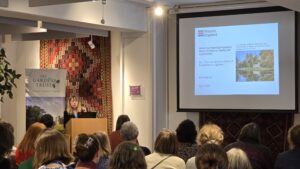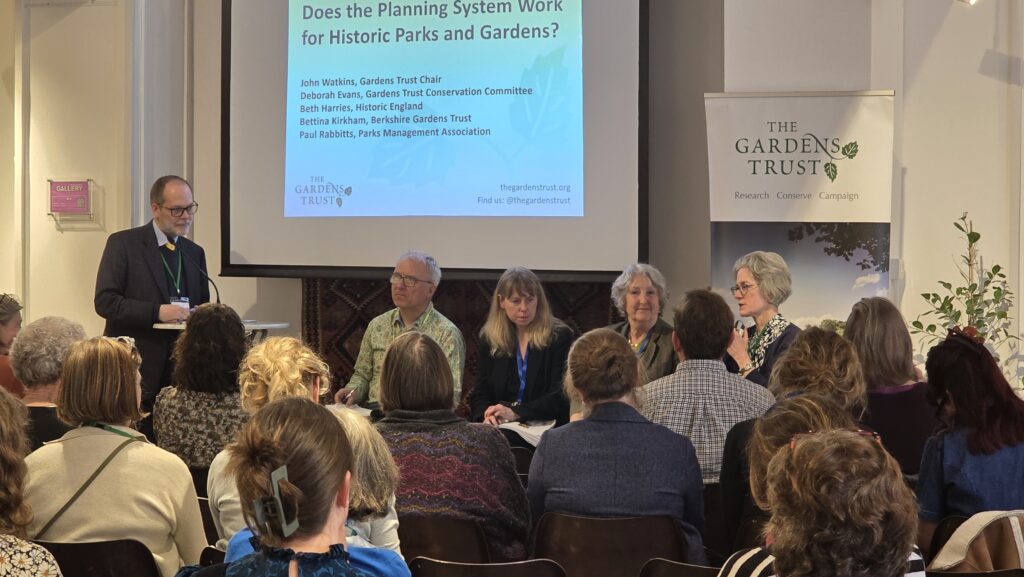This year’s Historic Designed Landscapes Assembly held at Cowcross Street, London, on Thursday 3rd April focused on the theme of historic parks and gardens in the planning system and was very timely with the Government’s announcement on the 10th March that the Gardens Trust’s statutory consultee status was under threat.
Our annual Assembly is an important opportunity for sector colleagues and allies to meet, and this year allowed people to begin to think about the implications of the Government’s proposals and nurture support for when the consultation is published.
There were 120 attendees, both in-person and online, from government departments and agencies such as the Department for Culture, Media and Sport, the Cabinet Office, Historic England and Natural England, landscape architecture practices to County Gardens Trusts to organisations such as the National Trust.
Our Chair-designate, John Watkins opened the assembly and set the day’s agenda of balancing growth with conserving our designed landscape heritage and learning from the past to create the next generation of valued parks and gardens.
Our morning speakers included: Deborah Evans, trustee, the Conservation Committee chair, and a landscape architecture consultant, with an overview of what the Gardens Trust brings to the planning system; Dr Victoria Thomson, another of our trustees and an expert historic environment planner, on the evolution of planning protection for historic parks and gardens, and the context for the statutory consultee provisions currently being reviewed; and Beth Harries, Historic England’s planning solicitor who took us through recent heritage case law and judgements that have tested key provisions such as the requirement to consult the Gardens Trust.
A panel discussion looked at whether the planning system actually works for historic parks and gardens, agreeing that lack of skills and knowledge is a critical issue, particularly with so little expert resource in local planning authorities, and so little commitment to high-quality design from many developers. Assembly delegates stressed that sharing of skills and information was key, but without the Gardens Trust to provide its expertise, they too would be limited in their activity. Others stressed the importance of supporting and championing high quality new design, to both add new layers to existing historic landscapes, and also to create the historic parks and gardens of the future.

The afternoon included a presentation by Daniel Bowles, in our Conservation Team, on examples from our planning advice casework to illustrate the range of development proposals and procedural issues we experience. These included enabling development housing adjacent to the Beth Chatto Gardens, Essex; lakeside developments in a separate landholding at Marston House, Somerset and retrospective planning permission for access and visitor facilities at Thornbridge Hall, Derbyshire/Peak District National Park. This was followed by presentations on unregistered designed landscapes and the Register of Parks and Gardens by two more Conservation Committee members and retired landscape architects, Bettina Kirkham and Jenifer White, respectively. Drawing on Berkshire Gardens Trust’s project to identify and record designed landscapes in the county, Bettina provided hands-on advice about getting sites added to Local Heritage Lists, Conservation Areas and referenced in Local Plans. Jenifer White picked up from the 2023 National Assembly’s focus on the National Heritage Act 1983 and the birth of the Register to canter through the planning development pressures and 1987 Great Storm landscape restoration work that escalated the development of the Register into a robust and authoritative resource with detailed and comparable site entries and maps.
The day was a vibrant and insightful coming together of those interested in the planning system from multiple perspectives. As the concluding remarks summed up: “We need to make the case for parks and gardens and how they are going to give us the future that we want.”
Stay tuned for news on the upcoming government consultation and how you can get involved by signing up to our e-bulletin.
For more information about events celebrating our 10th anniversary and more throughout the year, visit our events page.




